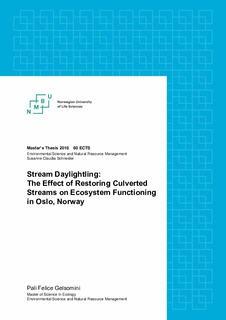| dc.contributor.advisor | Schneider, Susanne Claudia | |
| dc.contributor.advisor | Moe, Therese Fosholt | |
| dc.contributor.author | Gelsomini, Pali Felice | |
| dc.coverage.spatial | Norway, Oslo | nb_NO |
| dc.date.accessioned | 2018-10-30T14:51:26Z | |
| dc.date.available | 2018-10-30T14:51:26Z | |
| dc.date.issued | 2018 | |
| dc.identifier.uri | http://hdl.handle.net/11250/2570230 | |
| dc.description.abstract | Culverted streams generally have compromised ecological integrity due to issues with low light, extreme habitat modifications and increased pollution loadings. Restoring culverts back to aboveground streams has the potential to solve these issues. One of the main goals in restoration is restoring ecosystem services through renewed ecosystem functioning. Directly measuring ecosystem functions has the ability to serve as indictors for many, often hidden variables on a systems wide scale. This study compared the ecosystem functioning of restored stream stretches to reference stretches within the city of Oslo to assess the effectiveness of restoration efforts. Vegetation, hydromorphology and water chemistry are additionally analyzed to determine underlying causes for discrepancies. The measured ecosystem functions were total, microbial and invertebrate mediated decomposition, algae biomass accrual, algae primary production, and grazing intensity. Six daylighted sites were compared to twelve reference sites that had never before been culverted and covered a diverse array of habitats, water chemistries and degrees of urbanization. Decomposition was measured in late autumn using litter-pack methods with one-month exposure times, using two difference decay mediums: alder (Alnus glutinosa) leaves and Wettex cellulose sponge cloths. Algae and grazing metrics were measured using granite tiles as an artificial substrate placed in the stream for one month in spring. The data was analyzed using ANCOVA on mixed effect models and multiple linear regression. Regarding ecosystem functioning, it was found that restored stretches of stream responded the same to environmental variables as reference stretches, that had never before been culverted. The generally higher primary production and possibly lower rates of decomposition seen in restored stretches can be explained by the early-successional state of the newly constructed streams, with greater light intensity from more open canopies resulting in increased primary production and lower litter fall leading to lower capacity for decomposition. Restored streams had neither higher nor lower ecosystem functioning than natural streams of the same vegetation community, hydromorphology and water chemistry. This study concluded that stream daylighting efforts in Oslo have been successful at restoring ecosystem functioning to a level comparable to those of similar streams in the vicinity. | nb_NO |
| dc.language.iso | eng | nb_NO |
| dc.publisher | Norwegian University of Life Sciences, Ås | nb_NO |
| dc.rights | Attribution-NonCommercial-NoDerivatives 4.0 Internasjonal | * |
| dc.rights.uri | http://creativecommons.org/licenses/by-nc-nd/4.0/deed.no | * |
| dc.subject | Restoration | nb_NO |
| dc.subject | Daylight | nb_NO |
| dc.title | Stream daylighting : the effect of restoring culverted streams on ecosystem functioning in Oslo, Norway | nb_NO |
| dc.type | Master thesis | nb_NO |
| dc.source.pagenumber | 84 | nb_NO |
| dc.description.localcode | M-ECOL | nb_NO |

